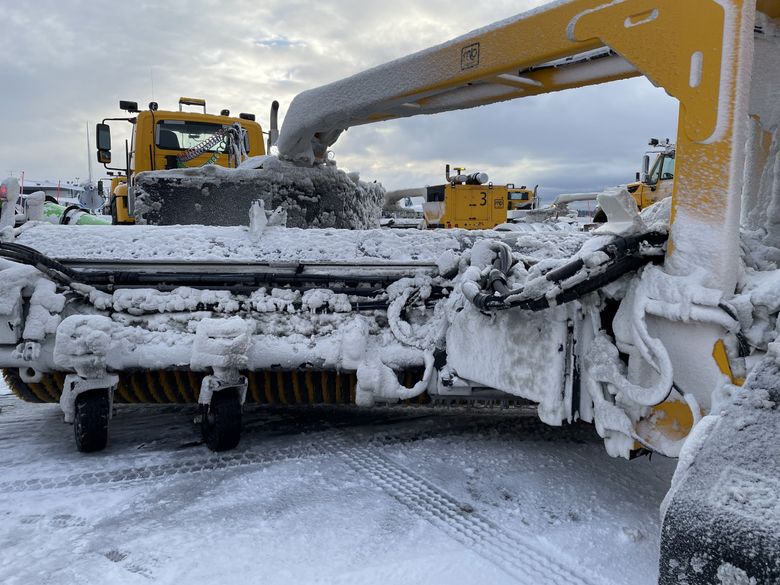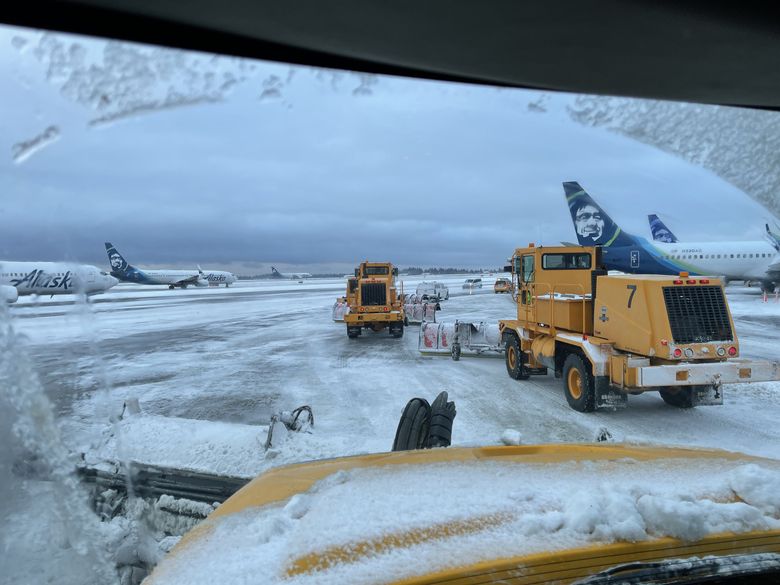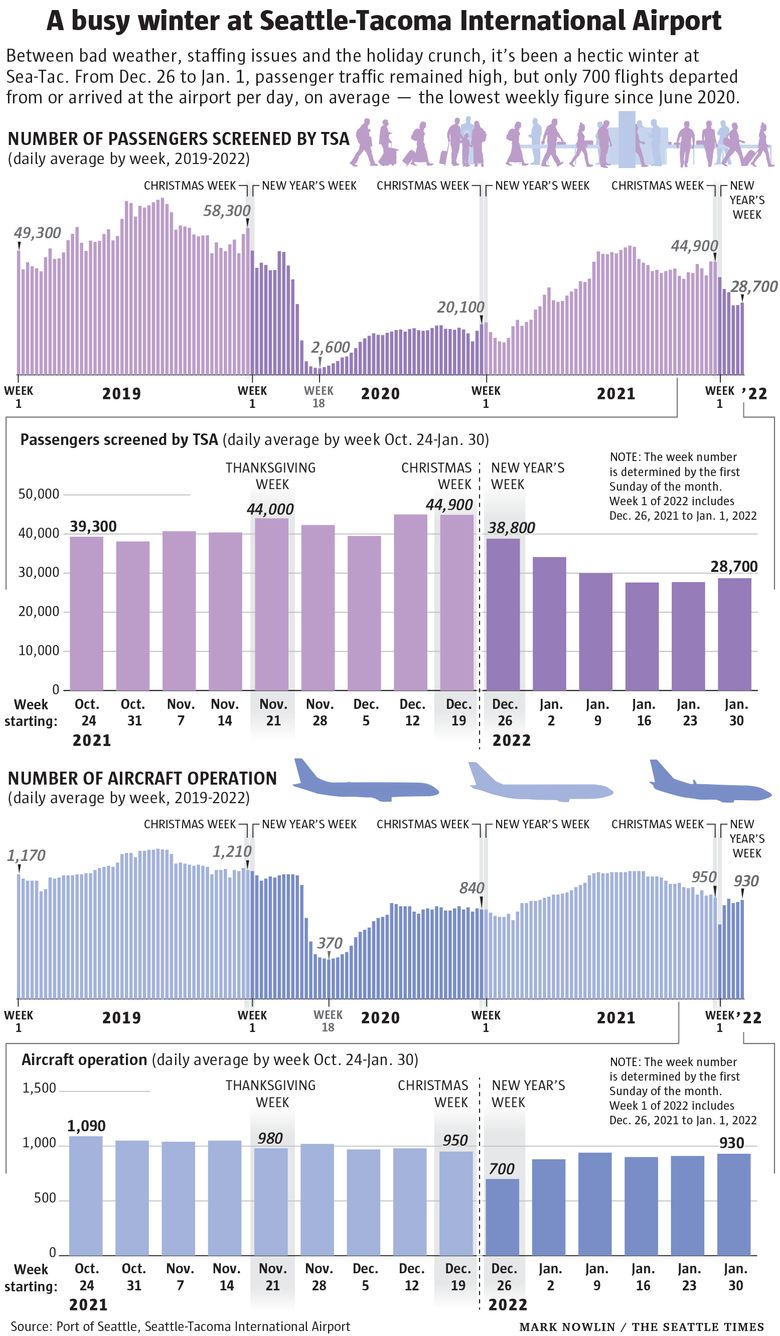Take a pandemic with a new, uber-contagious variant surging, throw in pounding snowstorms over the winter holidays, and top it off with a bureaucratic snarl of 5G rollout regulations: That’s a recipe for chaos at Seattle-Tacoma International Airport.
These stresses take their toll on travelers and travel-industry staff alike. Travelers, when stuck or delayed, feel helpless, with nothing to do but plead and vent with the nearest staff person. For airport-industry workers, there’s nothing worse than having to honestly answer, “There’s nothing more I can do.”
While 2022 is forecast to be another rebound year for travel, it will also be a highly volatile, unpredictable one. Looking behind the scenes at what was happening for Sea-Tac staff this winter may help travelers anticipate and cope with potential future disruptions.
Despite the headaches this winter, there were silver linings. Lisa Davis-Edeal, flight attendant for Horizon Air and president of Horizon’s chapter of the Association of Flight Attendants union, recalls an all-hands-on-deck response as airport workers of every stripe attempted to accommodate thousands of frustrated passengers.
Many hands make a lighter load when everything falls apart at once.
“Everything that can go wrong, did go wrong, over a period of about two and a half weeks,” said Terry Taylor, a flight attendant for Alaska Airlines for 49 years and Council 18 president for the Association of Flight Attendants-CWA. “It was a perfect storm.”
Omicron impacts
Heading into the holiday season, staffing levels across sectors at the airport were already low, despite hiring campaigns to recoup staff lost in the first year-plus of the pandemic.
The omicron variant, first confirmed in Washington in early December, began to spread among team members in waves. Fortunately, home tests and vaccines were more available than earlier in the pandemic, which sped up the return to work — as did the Centers for Disease Control and Prevention’s shorter, five-day quarantine recommendation — but healthy folks often had to take and are still taking double shifts or doing the work of several people, multiple sources said.
Pilots and flight crews need extra consideration — because their flight time is prescribed by Federal Aviation Administration regulations, if they take on extra shifts, they must stop working sooner, when they “time out.” Flight delays compound this, too.
Anticipating the holiday rush (and looking ahead), the Port of Seattle worked to streamline the travel experience by asking travelers to arrive early, take alternate transportation, pre-book security clearance and order food ahead. “Please pack your patience and arrive early,” it tweeted. You can find a list of tips at the Port of Seattle’s website.
Sleeping in the airport
Then came the snowstorms, a one-two punch of extended storms and temperatures plunging to 17 degrees. The first storm hit Dec. 26, dropping heavy snow across Puget Sound, and canceling 419 Sea-Tac flights, followed by 312 that Monday, according to Perry Cooper, spokesperson for Port of Seattle.
“Between Dec. 16 and Jan. 2, we had over 2,000 flights canceled, which represents about 12% [of the airport’s total scheduled flights],” Cooper said.
As a city, Seattle is not known for its snow-readiness — with too few plows and other equipment, even a few inches can shut down the city. As a result, omicron-stretched staffing was compromised further when road conditions snowed workers in at home.


Seattle-Tacoma International Airport has 45 pieces of equipment on hand for snow and ice removal, including these industrial-sized plows and brooms. (Courtesy of Seattle-Tacoma International Airport)
Administrators and supervisors went the extra mile to fill up their schedules — literally.
Tony Lomae — who, like many airport employees, works two jobs, including as a lavatory technician — said his manager was personally driving staff to work during the snowstorms. Alaska flight attendants were offered special incentive pay that was double-time level or better.
“Everyone was there to pick up the pieces, no matter who it was: management or union representatives,” said Davis-Edeal, the Horizon Air flight attendant and union chapter president. “Management was out shoveling snow, getting meals in, manning telephone lines trying to find hotel rooms — everyone did the best they could.”
“It was very busy [during the snow]. I’ve never seen it like that before,” said Ali Omisaye, who also works two jobs at the airport: as a wheelchair agent and as a supervisor driving golf carts from the terminal to the light-rail station.
“I worked at MSP airport in Minnesota. They’re not prepared in Seattle,” Omisaye said. “A lot of employees call in sick because of the snow emergency.” Omisaye was able to drive from West Seattle to do double shifts. The company he works for offered to put him up in a hotel, but he preferred to get home to his family.
Flight cancellations rippled out into further delays, staffing and supply shortages. Staffers redoubled their efforts to reschedule flights, de-ice runways and planes, clean and stock the restaurants and bathrooms — but it was hard to keep pace with the hurdles.
Passengers, whether bumped from a Seattle flight or rerouted from Portland or another snowed-in airport, flooded Seattle’s terminal. When the hotels filled up, people slept in places like the baggage claim area — for as long as it took.
Lomae saw many people stranded, but one woman stood out to him. “I saw her trying to ask about getting a [hotel] room,” he said. “I was feeling sorry about her. She’d been there for three days. She didn’t even have a phone … I wished she could not only take a rest, but take a shower and be comfortable.”
Sadia Bultum, a janitor since 2015, said during this time she and her co-workers “had to pull trash every 15 minutes” and clean bathrooms more often than usual. “Since we already had short staff, when people called in sick we don’t always have backup coverage,” she said. The mood of the staff was “unhappy, and tired,” she said.
“There were more cranky people because more people’s plans and lives had been disrupted and of course that’s understandable,” Taylor said. “I believe there were many people who tried to leave Seattle multiple times.”

One reason for this? “Some of our crew members were not returned timely enough to get to their next flight. It was sort of a cascading situation,” said Taylor, who represents approximately 2,500 Alaska flight attendants as the local union’s council president.
“We feel terrible when that happens. People have planned vacations, a limited amount of time, meetings or time spent with family over the holidays — nobody likes it when things go sideways,” Taylor said.
Port of Seattle data records highlight the pressure on the airport and its staff.
From Dec. 26 to Jan. 1, the Transportation and Security Administration screened an average of 38,800 passengers per day at Sea-Tac; there were just 700 airplane departures and arrivals on average daily.
A comparable week in 2021, with 38,200 average daily screened passengers, notched 1,160 takeoffs and landings; that is, 460 more flights to transport 600 fewer passengers per day.

That average aircraft operations figure of 700 is the lowest since June 2020.
During the snowstorms, Port of Seattle workers moved 600,000 cubic feet of snow and handed out more than 3,000 blankets to people stuck at the airport, Cooper said.
Tensions remained high among passengers left frustrated waiting for answers. One customer was told the wait time to reach an Alaska agent on the phone would be over 21 hours. Despite “working around the clock” to respond to customers, “the number of guests impacted far surpasses our ability to handle them in as quick and timely manner as we would like,” Seattle-based Alaska Airlines spokesperson Bobbie Egan told The Seattle Times in December. “It is not our finest moment and we feel terrible about the situation.”
Complicating matters at Horizon, Davis-Edeal explained: Many staffers were new hires who may not have been familiar with protocols.
A foggy rollout
The final wave came in January, when foggy conditions rolled in at the same time 5G was being rolled out. The FAA had just determined that the new higher frequencies used by cellphone carriers can interfere with altimeters — a part of the airplane’s navigation equipment that uses a very similar frequency. If that happens, the FAA says, it could prevent “engine and braking systems from transitioning to landing mode, which could prevent an aircraft from stopping on the runway.”
The combination is potentially deadly at low elevations with poor visibility, such as in fog. The FAA clears each aircraft to fly or land in 5G conditions based on how well its specific equipment can handle those conditions. The approval process grounded numerous planes, throwing flight schedules nationwide into chaos. Foggy weather benched or rerouted more planes.
Horizon Air had 67 flights canceled in one day, she said. The smallest disruption has a big impact. “We’re extremely lean in the regional side, so if something extreme happens to us, it’s a big problem,” she said.
“We had a flight attendant — she was stuck in Pasco I believe,” Davis-Edeal continued. “She’d been there for three days with her crew because of snowstorms, went back and was hit with the 5G cancellations. We heard regularly that people were without any communication.”
She explained how Paine Field in Everett shut down in the mornings and evenings, while fog cleared in the daytime — but by then, crews and aircrafts aren’t in the right places.
“You add more hours to everyone’s day, you have to find more crew and more aircrafts. And in the midst of that someone will be diagnosed with COVID, and you can’t fly without minimum crew,” Davis-Edeal said.
And that’s just the planning reconfiguration routine. On the plane, it’s a stress-endurance exercise, too.
“You’re watching for [people needing medical attention], seeing that people are not getting angry, keeping their masks on, getting water, that their basic needs are met,” Davis-Edeal said.
A five-hour flight with a generous layover can devolve into a 14-hour delay with no sleep. As staff “time out” due to regulations, they are replaced, interrupting workflow and team dynamics.
Lisa Davis-Edeal, a flight attendant for Horizon Air and president of Horizon’s chapter of the Association of Flight Attendants union, was among the countless airline industry workers at Seattle-Tacoma… (Ellen M. Banner / The Seattle Times)
“One FA reached out to us and had five separate crew changes in one day. For good crew-resource management, you want to keep the team together,” Davis-Edeal added. “You do debriefing before each leg, and you have to get to know each person as they come on.”
Since then, almost all Sea-Tac planes have been cleared for 5G flying. By Jan. 18, the FAA announced that roughly 62% of the commercial planes flown in the U.S. were cleared for flying in low visibility, including the Boeing 737 MAX; by Jan. 27, that figure reached 90%.
Looking ahead
Port of Seattle has several initiatives to support workers and passengers for travel in 2022. For workers, it has promoted job opportunities, handed out 2 million masks, hosted a pop-up vaccine clinic for airport workers, and campaigned for minimum wage requirements. For passengers, it will launch FlyWell, a campaign encouraging stress relief and management while traveling at the airport.
Taylor said Alaska is ramping up for a hiring campaign that should bring staff numbers past pre-COVID-19 levels.Saba Belachew, a lead wheelchair agent, works at the airport three days a week. She finds working with the public on the pandemic front lines daunting, but worth it.
“To be honest, it’s a really scary time. You’ll never be free like before. But still, we have to do what we have to do,” she said. “Personally, I love to help people by any means. When I help someone who really needs help, I am so happy.”
Like everyone else these days, many Sea-Tac workers look forward to a return to normal.
“Things have slowed down a little bit,” Lomae, the lavatory technician, said with relief regarding where things stand now as he headed out for another shift. “I hope everything will be great next year compared to this winter,” he said.
This story has been updated to reflect that passenger and aircraft operations statistics reported at Seattle-Tacoma International Airport represent average daily figures during the weeks in question. A previous version of the story suggested the figures represented weeklong totals for passenger traffic.
Erica Browne Grivas is a Seattle-based freelance writer; ebgrivas@gmail.com.